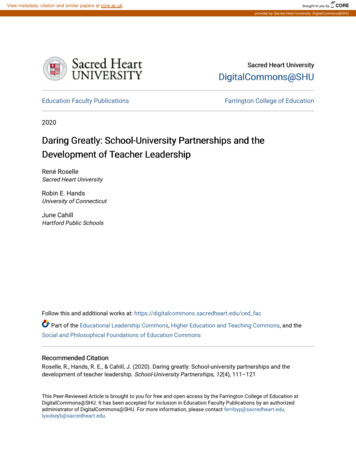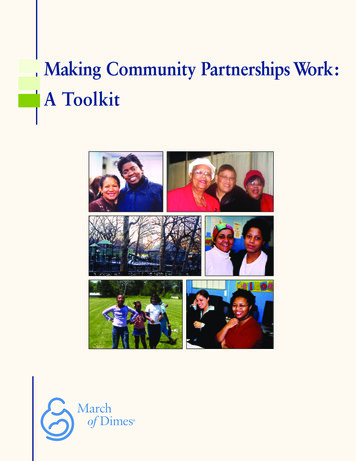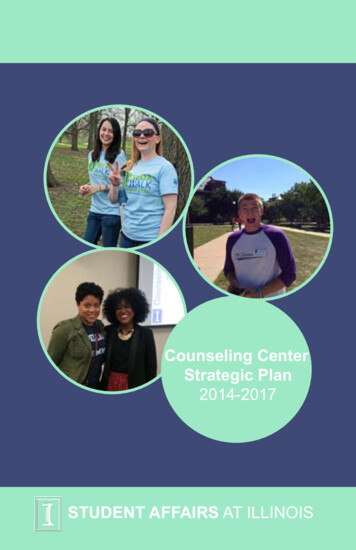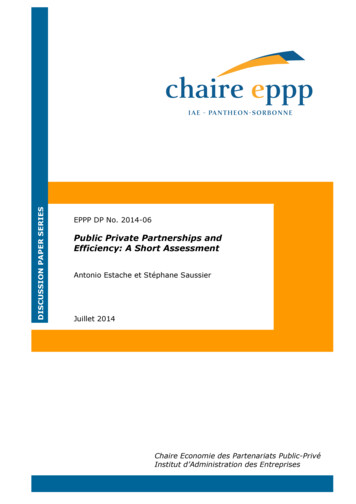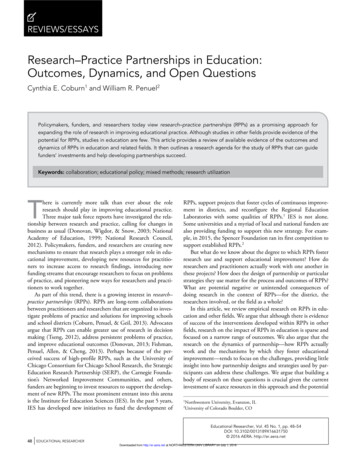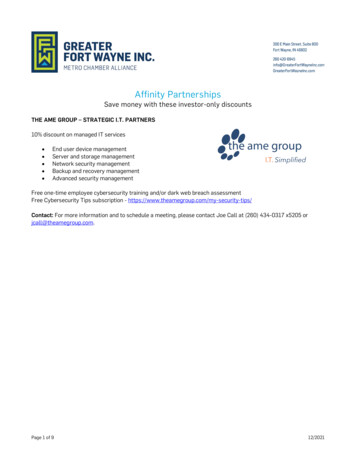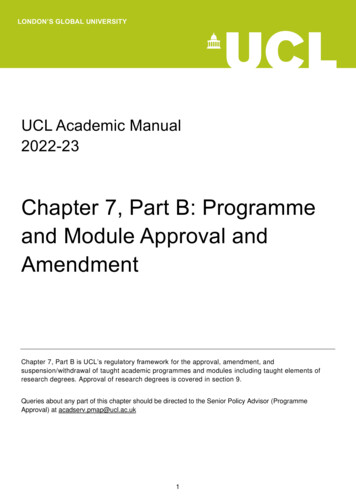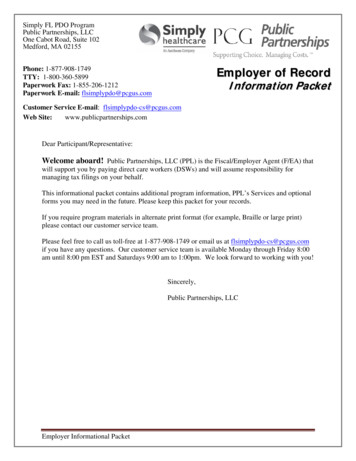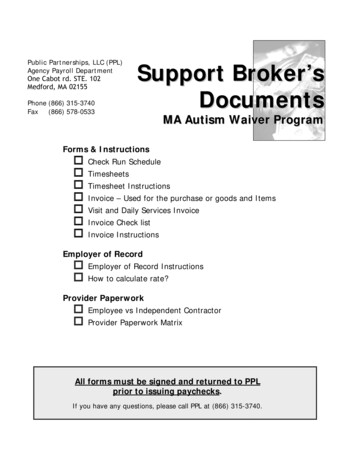
Transcription
School-Community Partnerships:A GuideThis Center is co-directed by Howard Adelman and Linda Taylor and operates under the auspices of theSchool Mental Health Project, Dept. of Psychology, UCLA.Center for Mental Health in Schools, Box 951563, Los Angeles, CA 90095-1563(310) 825-3634 Fax: (310) 206-5895; E-mail: smhp@ucla.edu Website: http://smhp.psych.ucla.eduPermission to reproduce this document is granted. Please cite source as the Center for Mental Health in Schools at UCLA.
School-Community Partnerships: A GuideTable of ContentsExecutive SummaryPrefaceIntroductionI. Why School-Community Partnerships?DefinitionsDimensions and CharacteristicsPrinciplesState of the ArtRecommendations to Enhance School-Community PartnershipsII. Building and Maintaining Effective CollaborativesBuilding from Localities OutwardMechanismsA Multi-Locality CollaborativeBarriers to CollaborationIII. Getting from Here to ThereWhat Are Some of the First Steps?Mechanisms for Systemic ChangeA Bit More about the Functions of a Change Agent and Change TeamA Note of CautionConcluding CommentsReferencesAppendicesA: A Comprehensive, Multifaceted Continuum of Intervention:Understanding the Big PictureB: Reported Examples of Successful School-Community InitiativesC: Melaville and Blank’s Sample of School-Community PartnershipsD: A Beginning Look at Major School-Community Partnerships in LA CountyResource AidsI. Tools for Mapping ResourcesII. Examples of Funding SourcesIII. Working with Others to Enhance Programs and ServicesIV. Tools for Gap Analysis and Action PlanningV. Using Data for Planning, Implementation, and EvaluationVI. Legal IssuesVII. Agencies and Online Resources Relevant to 8
Tables and FiguresTable 1. Some key dimensions relevant to family-community-school collaborative arrangements12Table 2. Four overlapping areas of school-community collaboration: A Local Example28Table 3. A range of community resources that could be part of a collaboration31Table 4. An overview of steps in moving school-community partnerships fromprojects to wide-spread practice44Figure 1a. Framework outlining areas for school-community collaboration.13Figure 1b. Nature and scope of collaboration.13Exhibit 1About collaborative infrastructure42Exhibit 2Examples of task activity for a change agent64Exhibit 3Planning and facilitating effective meetings66
School-Community Partnerships: A GuideExecutive SummaryRecent years have seen an escalating expansion in school-community linkages.Initiatives are sprouting in a rather dramatic and ad hoc manner.These efforts could improve schools, strengthen neighborhoods, and lead to amarked reduction in young people's problems. Or, such "collaborations" canend up being another reform effort that promised a lot, did little good, and evendid some harm. It is time to document and analyze what has developed andmove forward with a renewed sense of purpose and direction.This guidebook briefly underscores the “why” of school-family-community collaborations highlights their key facets sketches out the state of the art across the country offers some recommendations for local school and community policy makers discusses steps for building and maintaining school-community partnerships includes some tools for developing such partnerships.Why SchoolCommunityPartnerships?Policy makers mustrealize that, as importantas it is to reform andrestructure health andhuman services, suchservices remain only onefacet of a comprehensive,cohesive approach forstrengthening familiesand neighborhoods.Increasingly, it is evident that schools, families, andcommunities should work closely with each other to meettheir mutual goals. Schools are located in communities, but oftenare islands with no bridges to the mainland. Families live inneighborhoods, often with little connection to each other or to theschools their youngsters attend. Neighborhood entities such asagencies, youth groups, and businesses have major stakes in thecommunity. All these entities affect each other, for good or bad.Because of this and because they share goals related to educationand socialization of the young, schools, homes, and communitiesmust collaborate with each other if they are to minimize problemsand maximize results.Interest in working together is bolstered by concern aboutwidespread fragmentation of school and communityinterventions and problems of access. The hope is that byintegrating available resources, a significant impact can bemade on “at risk” factors. In particular, appropriate andeffective collaboration and teaming are seen as key facets ofaddressing barriers to development, learning, and family selfsufficiency.While informal school-family-community linkages arerelatively simple to acquire, establishing major long-termconnections is complicated. They require vision, cohesivepolicy, and basic systemic reform. The difficulties are readilyseen in attempts to evolve a comprehensive, multifaceted, andintegrated continuum of school-community interventions.Such a comprehensive continuum involves more than connecting with the community to enhance resources to supporti
instruction, provide mentoring, and improve facilities. Itinvolves more than school-linked, integrated services andactivities. It requires weaving school and communityresources together in ways that can only be achieved throughconnections that are formalized and institutionalized, withmajor responsibilities shared.What are SchoolCommunityPartnerships?School-community partnerships often are referred to ascollaborations. Optimally, such partnerships formally blendtogether resources of at least one school and sometimes agroup of schools or an entire school district with resources ina given neighborhood or the larger community. The intent isto sustain such partnerships over time. The range of entities ina community are not limited to agencies and organization;they encompass people, businesses, community based organizations, postsecondary institutions, religious and civic groups,programs at parks and libraries, and any other facilities thatcan be used for recreation, learning, enrichment, and support.School-community partnerships can weave together a criticalmass of resources and strategies to enhance caring communities that support all youth and their families and enablesuccess at school and beyond. Strong school-communityconnections are critical in impoverished communities whereschools often are the largest piece of public real estate andalso may be the single largest employer. Comprehensivepartnerships represent a promising direction for generatingessential interventions to address barriers to learning, enhancehealthy development, and strengthen families and neighborhoods. Building such partnerships requires an enlightenedvision, creative leadership, and new and multifaceted roles forprofessionals who work in schools and communities, as wellas for all who are willing to assume leadership.In thinking about school-community partnerships, it isessential not to overemphasize the topics of coordinatingcommunity services and co-locating services on school sites.Such thinking downplays the need to also restructure thevarious education support programs and services that schoolsown and operate. And, it has led some policy makers to themistaken impression that community resources can effectivelymeet the needs of schools in addressing barriers to learning.In turn, this has led some legislators to view the linking ofcommunity services to schools as a way to free-up the dollarsunderwriting school-owned services. The reality is that evenwhen one adds together community and school assets, thetotal set of services in impoverished locales is woefullyinadequate. In situation after situation, it has become evidentthat as soon as the first few sites demonstrating schoolcommunity collaboration are in place, community agenciesfind they have stretched their resources to the limit.ii
A Growing MovementProjects across the country demonstrate how schools and communities connect to improve results foryoungsters, families, and neighborhoods. Various levels and forms of school-community collaborationare being tested, including state-wide initiatives in California, Florida, Kentucky, Missouri, NewJersey, Ohio, and Oregon, among others. The aims are to improve coordination and eventuallyintegrate many programs and enhance linkages with school sites. To these ends, projects incorporateas many health, mental health, and social services as feasible into "centers" (including school-basedhealth centers, family and parent centers) established at or near a school. They adopt terms such asschool-linked and coordinated services, wrap-around, one-stop shopping, full service schools, systemsof care, and community schools. There are projects to (a) improve access to health and social services,(b) expand after school academic, recreation, and enrichment, (c) build systems of care, (d) reducedelinquency, (e) enhance transitions to work/career/post-secondary education, and (f) enhance life inschool and community.Such "experiments" have been prompted by diverse initiatives: some are driven by school reformsome are connected to efforts to reform community health and social service agenciessome stem from the youth development movementa few arise from community development initiatives.For example, initiatives for school-linked services often mesh with the emerging movement to enhancethe infrastructure for youth development. This growing youth development movement encompassesconcepts and practices aimed at promoting protective factors, asset-building, wellness, andempowerment. Included are (a) some full service school approaches, (b) efforts to establish“community schools,” (c) programs to mobilize community and social capital, and (d) initiatives tobuild community policies and structures to enhance youth support, safety, recreation, work, service,and enrichment. This focus on community embraces a wide range of stakeholders, including familiesand community based and linked organizations such as public and private health and human serviceagencies, schools, businesses, youth and faith organizations, and so forth. In some cases, institutionsfor postsecondary learning also are involved, but the nature and scope of their participation variesgreatly, as does the motivation for the involvement. Youth development initiatives expand interventionefforts beyond services and programs. They encourage a view of schools not only as communitycenters where families can easily access services, but also as hubs for community-wide learning andactivity. Increased federal funding for after school programs at school sites enhances this view byexpanding opportunities for recreation, enrichment, academic supports, and child care. Adulteducation and training at neighborhood school sites also help change the old view that schools closewhen the youngsters leave. Indeed, the concept of a "second shift" at school sites is beginning tospread in response to community needs.No complete catalogue of school-community initiatives exists. Examples and analyses suggestingtrends are summarized in this document. A reasonable inference from available data is that schoolcommunity collaborations can be successful and cost effective over the long-run. They not onlyimprove service access, they encourage schools to open their doors and enhance opportunities forrecreation, enrichment, remediation and family involvement. However, initiatives for enhancingschool-community collaboration have focused too heavily on integrated school-linked services. In toomany instances, school-linked services result only in co-locating agency staff on school campuses. Asthese activities proceed, a small number of youngsters receive services, but little connection is madewith school staff and programs, and thus, the potential impact on academic performance is minimized.iii
Recommendationsto Enhance SchoolCommunityPartnershipsSchool-community partnerships must not be limited to linkingservices. Such partnerships must focus on using all resources in themost cost-effective manner to evolve the type of comprehensive,integrated approaches essential for addressing the complex needs ofall youngsters, families, schools, and neighborhoods. This includesa blending of many public and private resources. To these ends, ahigh priority policy commitment at all levels is required that (a) supports the strategic development of comprehensive approaches byweaving together school and community resources, (b) sustainspartnerships, and (c) generates renewal. In communities, the need isfor better ways of connecting agency and other resources to eachother and to schools. In schools, there is a need for restructuring tocombine parallel efforts supported by general funds, compensatoryand special education entitlement, safe and drug free school grants,and specially funded projects. In the process, efficiency and effectiveness can be achieved by connecting families of schools, such ashigh schools and their feeder schools.School-community partnerships require a cohesive set of policies. Cohesive policy will onlyemerge if current policies are revisited to reduce redundancy and redeploy school andcommunity resources that are used ineffectively. Policy must move existing governance toward shared decision making and appropriate degrees of localcontrol and private sector involvement -- a key facet of this is guaranteeing roles andproviding incentives, supports, and training for effective involvement of line staff,families, students, and other community members create change teams and change agents to carry out the daily activities of systemic changerelated to building essential support and redesigning processes to initiate, establish, andmaintain changes over time delineate high level leadership assignments and underwrite essential leadership/management training re. vision for change, how to effect such changes, how to institutionalizethe changes, and generate ongoing renewal establish institutionalized mechanisms to manage and enhance resources for schoolcommunity partnerships and related systems (focusing on analyzing, planning, coordinating, integrating, monitoring, evaluating, and strengthening ongoing efforts) provide adequate funds for capacity building related to both accomplishing desired systemchanges and enhancing intervention quality over time -- a key facet of this is a majorinvestment in staff recruitment and development using well-designed, and technologicallysophisticated strategies for dealing with the problems of frequent turnover and diffusinginformation updates; another facet is an investment in technical assistance at all levels andfor all aspects and stages of the work use a sophisticated approach to accountability that initially emphasizes data that can helpdevelop effective approaches for collaboration in providing interventions and a resultsoriented focus on short-term benchmarks and that evolves into evaluation of long-rangeindicators of impact. (Here, too, technologically sophisticated and integrated managementinformation systems are essential.)Such a strengthened policy focus would allow personnel to build the continuum of interventionsneeded to make a significant impact in addressing the health, learning, and well being of allyoungsters through strengthening youngsters, families, schools, and neighborhoods.iv
Guidelines and Strategies forBuilding and Maintaining School-Community PartnershipsAdopting a scale-up model. Establishing effective school-community partnerships involvesmajor systemic restructuring. Moving beyond initial demonstrations requires policies andprocesses that ensure what often is called diffusion, replication, roll out, or scale-up.Too often, proposed systemic changes are not accompanied with the resourcesnecessary to accomplish essential changes throughout a county or even a schooldistrict. Common deficiencies include inadequate strategies for creating motivationalreadiness among a critical mass of stakeholders, assignment of change agents withrelatively little specific training in facilitating large-scale systemic change, andscheduling unrealistically short time frames for building capacity to accomplish desiredinstitutional changes. The process of scale-up requires its own framework of steps, theessence of which involves establishing mechanisms to address key phases, tasks, andprocesses for systemic change. These are described in section III of this document.Fourteen steps for moving school-community partnerships from projects to widespread practice are outlined.Building from localities outward. From a decentralized perspective and to maintain thefocus on evolving a comprehensive continuum of programs/services that plays out inan effective manner in every locality, it is a good idea to conceive the process fromlocalities outward. That is, first the focus is on mechanisms at the school-neighborhoodlevel. Then, based on analyses of what is needed to facilitate and enhance efforts at alocality, mechanisms are conceived that enable several school-neighborhoodcollaborations to work together to increase efficiency and effectiveness and achieveeconomies of scale. Then, system-wide mechanisms can be (re)designed to providesupport for what each locality is trying to develop.Building capacity. An infrastructure of organizational and operational mechanisms atall levels are required for oversight, leadership, resource development, and ongoingsupport. With each of these functions in mind, specific mechanisms and their interrelationship with each other and with other planning groups are explored. Key mechanisms include change agents, administrative and staff leads, resource-oriented teams andcouncils, board of education subcommittees, and so forth. The proposed infrastructureprovides ways to (a) arrive at decisions about resource allocation, (b) maximizesystem-atic and integrated planning, implementation, main-tenance, and evaluation ofenabling activity, (c) outreach to create formal working relationships with communityresources to bring some to a school and establish special linkages with others, and (d)upgrade and modernize the component to reflect the best intervention thinking and useof technology. At each level, these tasks require that staff adopt some new roles andfunctions and that parents, students, and other representatives from the communityenhance their involvement. They also call for redeployment of existing resources, aswell as finding new ones. (Appendices provide tools and resource to aid in capacitybuilding.)v
PrefaceFamilies have always provided a direct connection between school and community.Recent years have seen an escalating expansion in school-community linkages.Initiatives have sprouted in a rather dramatic and ad hoc manner. It is time to clarifya big picture, document and analyze what has developed, and move forward with arenewed sense of purpose and direction.This guidebook briefly (a) underscores the “why” of school-community partnerships,(b) highlights their nature and key dimensions, (c) sketches out the state of the artacross the country and in L.A. County, (d) offers some recommendations for localschool and community policy makers, (e) discusses steps for building andmaintaining school-community partnerships, and (f) includes some tools fordeveloping such partnerships.This document was developed with three objectives in mind: to enhance understanding of the concept of school-community partnerships to convey a sense of the state of the art in a way that would underscoredirections for advancing the field to provide some tools for those interested in developing and improving theways schools and communities work together in the best interests of youngpeople and their families.In a real sense, the entire document is meant to be a toolkit. The material containedhere can be drawn upon to develop a variety of resource aids. Given the differentgroups of stakeholders who must be involved if school-community partnerships areto succeed, there is a need to prepare brief introductions to the topic and developpresentation materials to fit each audience (e.g., community members, practitioners,policy makers). You will certainly want to rewrite sections to fit your specificobjectives and to enhance readability for a given audience. You will also want to addattractive design and formatting touchesTreat the material as a starting point. Feel free to use whatever you find helpful andto adapt it in any way that brings the content to life.Note: A great many references have been drawn upon in preparing this guide. These are includedin a special reference section. Individual citations in the text are made only to credit sources forspecific concepts, quotes, and materials.1
I NTRODUCTIONCollaboratives are sprouting in adramatic and ad hoc manner. Properlydone, collaboration among schools,families, and communities shouldimprove schools, strengthen familiesand neighborhoods, and lead to amarked reduction in young people'sproblems. Alternatively,poorlyimplemented "collaborations" can endup being another reform effort thatpromised a lot, did little good, and evendid some harm.recreation, learning, enrichment, andsupport.Leaders for fostering family,community, and school connectionshave cautioned that some so-calledcollaborations amount to little more thangroups of people sitting aroundengaging in “collabo-babble.” Yearsago, former Surgeon General JocelynElders cautioned: "We all say wewant to collaborate, but what we reallymean is that we want to continue doingthings as we have always done themwhile others change to fit what we aredoing."While it is relatively simple to makeinformal linkages, establishing majorlong-term collaborations is complicated.Doing so requires vision, cohesivepolicy, and basic systemic reforms. Thecomplications are readily seen in anyeffort to develop a comprehensive,multifaceted, and integrated approach topromoting healthy development andaddressing barriers to development andlearning. Such an approach involvesmuch more than linking a few services,recreation, and enrichment activities toschools. Major systemic changes arerequired to develop and evolve formaland institutionalized sharing of a widespectrum of responsibilities andresources.One of the most important, crosscutting social policy perspectives toemerge in recent years is anawareness that no single institutioncan create all the conditions thatyoung people need to flourish . . . .Melaville & Blank, 1998An optimal approach involves formallyblending together resources of at leastone school and sometimes a group ofschools or an entire school district withlocal family and community resources.The intent is to sustain connections overtime. The range of entities in acommunity are not limited to agenciesand organization; they encompasspeople, businesses, community basedorganizations,postsecondaryinstitutions, religious and civic groups,programs at parks and libraries, and anyother facilities that can be used forCollaboratives can weave together acritical mass of resources and strategiesto enhance caring communities thatsupport all youth and their families andenable success at school and beyond.Strong family-school-communityconnections are critical in impoverishedcommunities where schools often are the2
to free-up the dollars underwritingschool-owned services. The reality isthat even when one adds togethercommunity and school assets, the totalset of services in impoverished locales iswoefully inadequate. In situation aftersituation, it has become evident that assoon as the first few sites demonstratingschool-community collaboration are inplace, local agencies find they havestretched their resources to the limit.Policy makers must realize thatincreasing access to services is only onefacet of any effort to establish acomprehensive, cohesive approach forstrengthening families andneighborhoods.largest piece of public real estate andalso may be the single largest employer.Comprehensive collaboration representsa promising direction for efforts togenerate essential interventions toaddress barriers to learning, enhancehealthy development, and strengthenfamilies and neighborhoods. Buildingsuch collaboration requires stake-holderreadiness, an enlightened vision,creative leadership, and new and multifaceted roles for professionals whowork in schools and communities, aswell as for family and other communitymembers who are willing to assumeleadership.Collaboratives often are establishedbecause of the desire to address a localproblem or in the wake of a crisis. In thelong-run, however, family-communityschool collab-oratives must be driven byacomprehensive vision aboutstrengthening youngsters, families,schools, and neighborhoods. Thisencompasses a focus on safe schools andneighborhoods, positive developmentand learning, personal, family, andeconomic well-being, and more.As noted, interest in connectingfamilies, schools, and communities isgrowing at an exponential rate. Forschools, such links are seen as a way toprovide more support for schools,students, and families. For agencies,connection with schools is seen asproviding better access to families andyouth and thus as providing anopportunity to reach and have an impacton hard-to-reach clients. The interest incollaboration is bolstered by therenewed concern about widespreadfragmentation of school and communityinterventions. The hope is thatintegrated resources will have a greaterimpact on “at risk” factors and onpromoting healthy development.It is commonly said that collaborativesare about building relationships. It isimportant to understand that the aim isto build potent, synergistic, workingrelationships, not simply to establishpositive personal connections.Collaboratives built mainly on personalconnections are vulnerable to themobility that characterizes many suchgroups. The point is to establish stableand sustainable working relationships.This requires clear roles,responsibilities, and an institutionalizedinfrastructure, including well-designedmechanisms for performing tasks,solving problems, and mediatingconflict.In fostering collaboration, it is essentialnot to limit thinking to coordinatingcommunity services and collocatingsome on school sites. Such an approachdownplays the need to also restructurethe various education support programsand services that schools own andoperate. And, it has led some policymakers to the mistaken impression thatcommunity resources can effectivelymeet the needs of schools in addressingbarriers to learning. In turn, this has ledsome legislators to view the linking ofcommunity services to schools as a wayA collaborative needs financial support.The core operational budget can be3
The governance of the collaborativemust be designed to equalize power sothat decision making appropriatelyreflects all stakeholder groups and sothat all are equally accountable . Theleadership also must includerepresentatives from all groups, and allparticipants must share in the workload– pursuing clear roles and functions.And, collaboratives must be open to allwho are willing to contribute theirtalents.direct funding and in-kind contributionsfrom the resources of stakeholdergroups. A good example is the provisionof space for the collaborative. A schoolor community entity or both should beasked to contribute the necessary space.As specific functions and initiatives areundertaken that reflect overlappingarenas of concern for schools andcommunity agencies such as safeschools and neighborhoods, someportion of their respective fundingstreams can be braided together. Finally,there will be opportunities tosupplement the budget with extra-muralgrants. A caution here is to avoidpernicious funding. That is, it isimportant not to pursue funding forprojects that will distract thecollaborative from vigorously pursuingits vision in a cohesive (nonfragmented)manner.Obviously, true collaboration involvesmore than meeting and talking. Thepoint is to work together in ways thatproduce the type of actions that result inimportant results. For this to happen,steps must be taken to ensure thatcollaboratives are formed in ways thatensure they can be effective. Thisincludes providing them with thetraining, time, support, and authority tocarry out their roles and functions. It iswhen such matters are ignored thatgroups find themselves meeting andmeeting, but going nowhere.It’s not about a collaborative . . . it’s about collaborating to be effective4
Section I: Why School-Community Partnerships?Why School-Community Partnerships? To enhance effectiveness To provide a comprehensive, multifaceted, and integratedcontinuum of interventions To support all youth & families Hawaii’s Healthy Children Healthy Communities modelDefinitionsPrinciplesDimensions and Characteristics Table 1: Some key dimensions relevant to family-communityschool collaboration Figure 1A: Framework outlining areas for school-communitycollaboration Figure 1B: Nature and scope of collaboration principlesState of the Art A growing movement across the country School-family partnerships Family and citizen involvement Enhanced support, access, & impact An example of why collaboration is needed What it looks like from a community-wide perspective Table 2: Four overlapping areas of school-communitycollaboration in Los Angeles County Table 3: A range of resources that could be part of acollaborationRecommendations to Enhance School-Community Partnerships Partnerships in rural school districts Public Schools and Their Communities: Executive Summary5
Why School-Community Partnerships?Schools are located in communities, but often are islandswith no bridges to the mainland. Families live inneighborhoods, often with little connection to each other orto the schools their youngsters attend. Nevertheless, all theseentities affect each other, for good or bad. Because of
Table 2. Four overlapping areas of school-community collaboration: A Local Example 28 Table 3. A range of community resources that could be part of a collaboration 31 Table 4. An overview of steps in moving school-community partnerships from 44 projects to wide-spread practice Figure 1a. Framework outlining areas for school-community .
